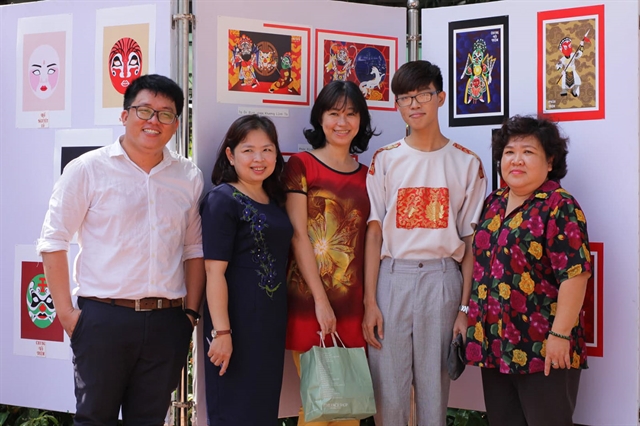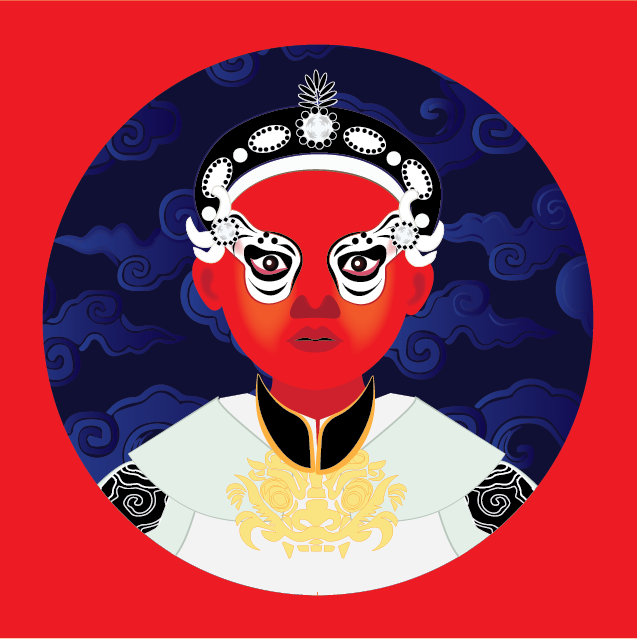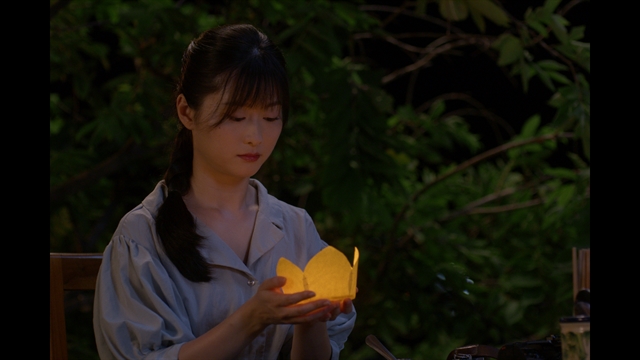 Features
Features

Nguyễn Đức Huy has his own way of arousing interest in Vietnamese hát bội (classical opera) – painting hát bội characters in a chibi style.

|
| Chibi hát bội figures by Nguyễn Đức Huy perform on a miniature stage. Photo courtesy of Nguyễn Đức Huy |
By Hồ Trinh – Lương Hương
Nguyễn Đức Huy has his own way of arousing interest in Vietnamese hát bội (classical opera) – painting hát bội characters in a chibi style.
The characters are small and chubby, with stubby limbs and oversized heads to make them resemble children.
The collection of characters is part of the project Sài Gòn Hí Viện, featuring hát bội figures like Khương Linh Tá, Mộc Quế Anh and Thần Nữ, along with unique hát bội masks.
“By painting in this style, I want to offer a new and modern perspective on traditional art for young people,” the student of Tôn Đức Thắng University in HCM City said.

|
| Nguyễn Đức Huy (second from right) creates Chibi hát bội figures with the aim of attracting more youngsters to the traditional art form. Photo courtesy of Nguyễn Đức Huy |
From a young age, Huy was interested in studying the traditional arts of southern Việt Nam, and hát bội was one of them.
The more he learned about hát bội from the internet and books, the more he realised it was in danger of being lost.
The idea of how to save the traditional art that used to be widely popular in the south obsessed the young man.
After graduating from high school, he decided to apply for the Faculty of Graphic Design at Tôn Đức Thắng University.
Huy said he could never become a hát bội artist, but his gift for painting allowed him to enliven hát bội characters.
At the end of the second term, each student had to choose a topic. While others chose modern styles, Huy chose music, specifically hát bội, and embarked on the Sài Gòn Hí Viện project which aims to provide a new perspective on traditional theatre and bring it closer to the community.
Initially, the project included paintings of 12 hát bội characters like Khương Linh Tá, Trương Phi and Tạ Ôn Đình painted in chibi style with strong colours. Then Huy kept on studying and created more figures to enrich his collection.
Though painting on specialised graphic software – Adobe Illustrator, it took him three days to finish the Sài Gòn Hí Viện project.
After university, Huy continued to study the art form on the internet, whilst visiting museums and talking with hát bội artists to ask about the makeup, costumes and actions of each figure.

|
| A chibi painting by Nguyễn Đức Huy portraying hát bội character Phàn Diệm. Photo courtesy of Nguyễn Đức Huy |
“It takes me just several hours to paint simple, gentle characters, but it might take weeks to create evil and sophisticated ones. I don't paint the original figures; I try to add more creative elements to attract young people,” Huy revealed.
He also adds specific notes about each hát bội figure to provide background information for viewers with little understanding of the traditional art.
To arouse interest in hát bội, viewers need to be able to recognise the figures, and distinguish them as good or bad characters and understand the implications of their acts.
“People love the beauty and the content. As long as they understand, they are naturally interested,” he said.
Huy also had the idea of putting his chibi characters on stage by creating miniature theatres in which they perform excerpts from plays.
“I enjoy turning the old into new. Traditional culture is largely ignored by young people. I want to renovate it with a modern style to entice them. I hope I can make people who have never seen hát bội to get curious,” he added.
Realising the meaning of the Sài Gòn Hí Viện project, Huy’s teachers and friends have helped him to hold an exhibition. The project has succeeded beyond expectations by drawing attention from many people, particularly students.
That project has concluded, but there's more good news for the 21-year-old student because more organisations and individuals have commissioned posters from him and asked him to design stages for art events.
“I'm really happy because people are looking at my creations. I haven't made much money, but I feel like a success because I'm living my passion and sharing my work with others who share the same interests,” he said.
But that’s not the end to his idea to renew and popularise hát bội. He is studying how to print his chibi paintings on packaging and labels, and he has established a facebook fanpage Dấu Ấn Sài Gòn (Sài Gòn Imprints). The page contains detailed notes about various art forms to prepare for the release of his book, Đường Vào Hát Bội (Road to Hát Bội).
“It is a positive sign that Huy’s creations with hát bội like postcards, paintings and stickers have been well received by the public,” commented cultural researcher Huỳnh Ngọc Trảng. “That is thanks to Huy pursuing his own direction based on his passion.” VNS
Coming from the 12th century, hát bội or tuồng developed from a folk art to a royal art. The art consists of singing and dancing to music. Its themes include monarchist loyalty and patriotic duty, which define the play’s structure, features, language, music, colour and characters' struggles and personalities.
The art showcases the spirit and characters of Vietnamese people.




